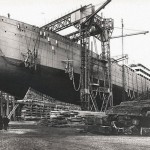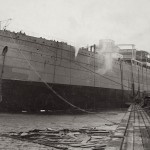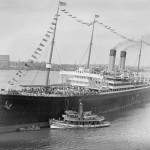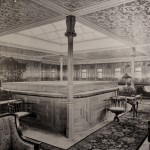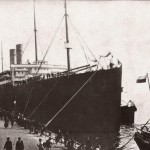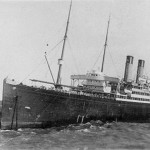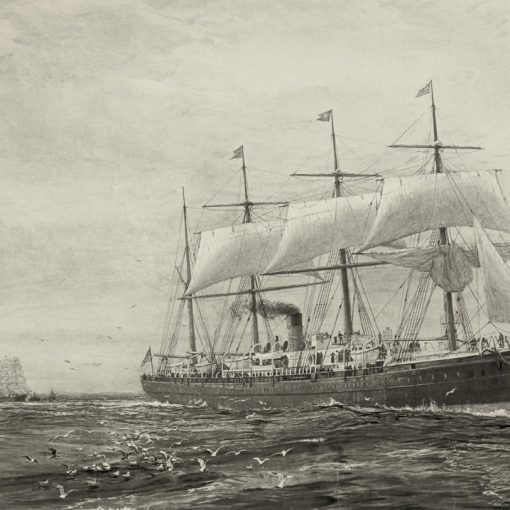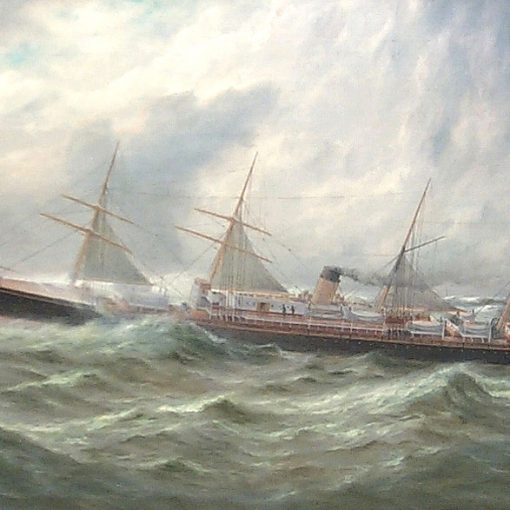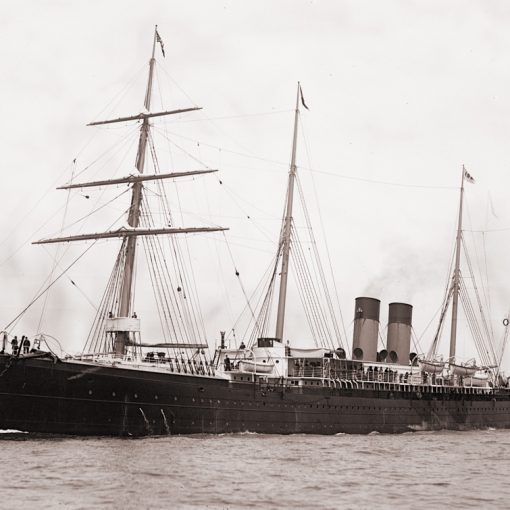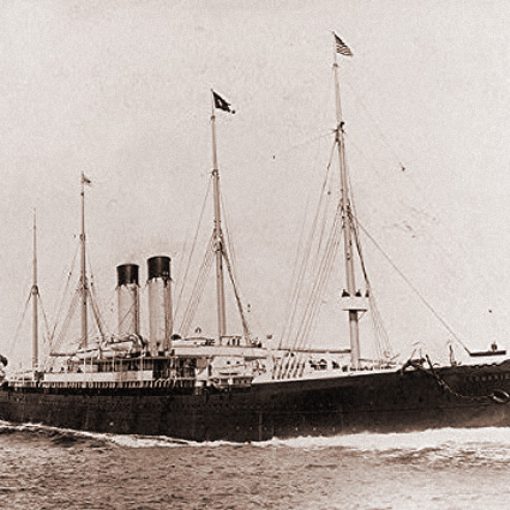1901 – 1928
After the death of Thomas Henry Ismay in 1899, White Star Line’s planned sister vessel to the Oceanic – the Olympic – had been suspended. Instead, all strength was placed in the company’s new project; to build the grandest fleet of ships that had ever sailed the seas.
Already in 1899 had the White Star Line shown its supremacy by exceeding the Great Eastern in length with the 705 feet long Oceanic. But Isambard Brunel’s colossus had not yet been surpassed in tonnage. The Oceanic ‘only’ had a gross tonnage of 17,000 tons compared to the Great Eastern’s 19,000.
This new fleet that the White Star Line was about to produce would consist of four vessels: The Big Four. All of these would each have a gross tonnage of over 20,000 tons. The first of the sisters, actually ordered by Thomas Ismay himself before his death, would be named Celtic. She would be followed by the Cedric, and later by the Baltic and Adriatic. The two first sisters would be much the same in appearance, just as the two later ones would be. As everyone already has figured, the name ‘Celtic’ refers to the ancient Celts. But strangely the name of the ship was pronounced differently; [Keltik] would be normal, but instead [Seltik] was used.
The Celtic would be slightly shorter than the Oceanic in length, but still longer than the Great Eastern, at 700 feet she would be the second longest ship in the world. But as her tonnage was over 21,000 tons, the Celtic was claimed to be the largest ship ever constructed.
Back in the late 1880s and early 1890s, the White Star Line had operated the fastest ships in the world; the Teutonic and Majestic, but at the time of the arrival of the Celtic, the company aimed at comfort, size and steadiness rather than speed. The Oceanic, who wore a certain resemblance to the Big Four had had a service speed of 19.5 knots, but to conserve fuel, the Celtic and her sisters would only steam along in 16 knots. The Blue Riband was deliberately handed over to Cunard and the German shipping companies. Even though this pedestrian speed, the Celtic became highly popular on the Liverpool-New York route.
On April 4, 1901 the new Celtic was launched without any mishaps. On July 4, she was handed over to the White Star Line and began her maiden voyage to New York on the 26th. The approach to New York Harbour had to be deepened in order to take the new 21,000-tonner.
To celebrate her greatness, the largest vessel in the world made a Mediterranean cruise for five weeks, starting in February 1902, carrying 800 passengers. After this joyful voyage she was returned to her North Atlantic service.
In 1903, the Celtic was joined by her sister, the Cedric, who was at the same size as the first sister, except that the Cedric had a net tonnage 71 tons more than the Celtic. That placed Celtic one step down on the list concerning the largest ships in the world. However, popularity did not decrease, and on one westbound voyage in 1904, the Celtic carried 2,957 souls on board, including crew, the highest so far for the company. The same year another ship was added to the Celtic and Cedric; the 23,000-tonner Baltic. That vessel had now replaced Cedric as the world’s largest.
In 1907 the Celtic sailed for the American Line for a brief time. Even though she was not directly under White Star’s command, she remained in her original colours. That same year the last of the Big Four was added to the White Star fleet. She was the Adriatic, but at 24,000 tons she did not became the largest in the world. The 31,000-tonner Lusitania had been launched months before. Thus had all but one of the Big Four for some time been the largest vessel ever constructed.
When the great war began in 1914, the Celtic was withdrawn from her peacetime service and converted into an Armed Merchant Cruiser with 8 x 6 inch guns. On the fourth of December she was added to the 10th Cruiser Squadron. But, as it would show, large ships were not suited for war cruising because of their enormous consumption of coal. In a matter of months all of Britain’s coal supplies were gone. So, in January 1916, the Celtic was instead converted as a troopship assigned to carry soldiers to Egypt. In March she was back on her Liverpool-New York run, but still able to quickly be converted back. Her voyages continued without any major mishaps, but in 1917, the Celtic struck a mine outside Isle of Man laid by the German U-boat U-80, and 17 people on board the steamer were killed by the explosion. The London & N. Western Rly Co. ship Slieve Bawn picked up the passengers and brought them to Holyhead in north-western Wales. Fortunately, the Celtic was not mortally wounded, and she was towed into Peel Bay. The vessel was taken to Belfast where she was repaired. Shortly afterwards the Celtic was again on the Liverpool-New York route. In May the same year the Germans were at it again. This time they failed to hit the ship, though, and the ship went on, unscathed. But the never-ending self-confidence of the Germans continued, and in March 1918, the Celtic was torpedoed in the Irish Sea by the UB-77. Six people on the Celtic were killed when the torpedo hit its target. The Celtic’s luck continued and she was not sunk. Instead she was towed to Liverpool where Harland and Wolff repaired her. The vessel was soon back in service, and at the war’s end in 1918, she was still intact. Her wartime duties lasted until 1919, when she was returned to the White Star Line. She immediately sailed for Belfast where she was refitted for peacetime service. In 1920, the Celtic made her first crossing over the Atlantic.
On April 25, 1925, the ship collided with the Coast Line’s Hampshire Coast in the Irish Sea. The Celtic seemed unharmed whilst the Hampshire Coast had suffered badly from the collision. She was afloat but that was the only thing she was. Luckily, the smaller ship made off to port safely. Another minor collision between the Celtic and the American steamer Anaconda occurred in 1927, but none of the ships were especially damaged. The same year, the old three-class system on board the Celtic was left behind and the ship was turned into a Cabin Class ship with place for 2,500 passengers.
On one unfortunate voyage in 1928 just outside Cobh (Queenstown) the Celtic was grounded on Roches Point. The engines were ordered full astern, and she came off, but only to be grounded again on Calf Rocks. The ship did not want to move, and after some failed salvage attempts, the Celtic was declared a total loss. In order to take off all her passengers and cargo, a bridge was constructed between the ship and the land. On this bridge all of the ship’s rats left the ship when they felt that something was wrong with their enormous home. The Celtic’s two funnels were immediately cut down, because they hindered the Roches Point Lighthouse beam. The wreck was sold to Petersen and Albeck, a Danish company. They broke the Celtic up where she lay. After the White Star Line had accepted the Celtic as a loss, they replaced her with the smaller ex-German Albertic (laid down as the München). In 1933, the last remains of the great Celtic was taken away.
Specifications
- 700 feet (213.8 m) long
- 75.3 feet (23 m) wide
- 21,035 gross tons
- Two quadruple-expansion engines powering two propellers
- 16 knot service speed
- Passenger capacity of 2,857 people

